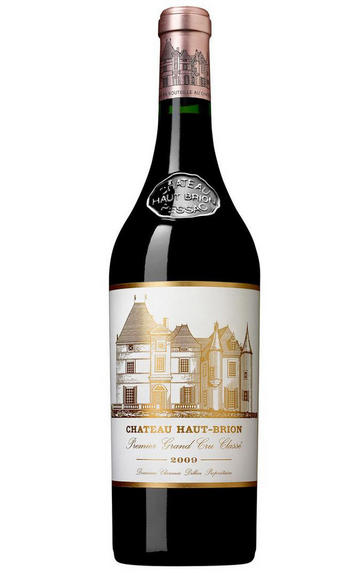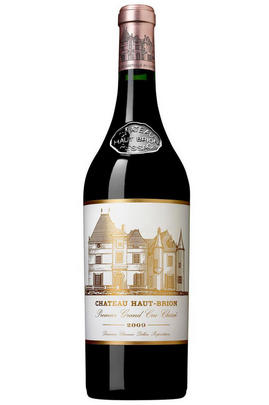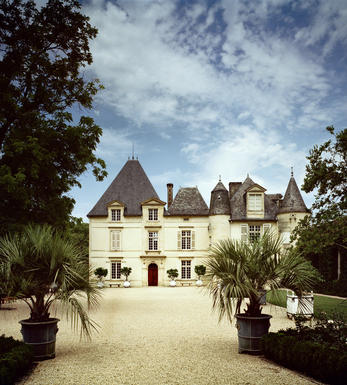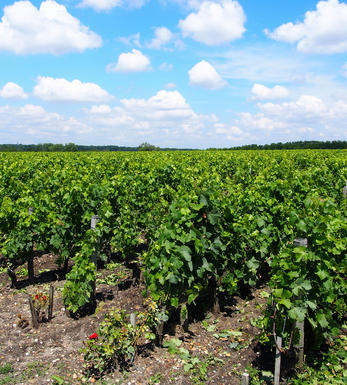
2008 Château Haut-Brion, Pessac-Léognan, Bordeaux

Critics reviews
The 2008 Haut Brion has a very perfumed and floral bouquet: ebullient raspberry coulis and crushed strawberry fruit, sage and a hint of black olive. It just builds momentum in the glass. The palate is medium-bodied with fine tannin. It feels a little grainy in texture, centered upon gravelly black fruit laced with black olive and smoke. It felt more austere than I expected, the finish reserved and somehow "contained" and yet the aftertaste is extraordinarily long. Avoid opening bottles for now because this was always one of the standout wines of the vintage, but at 10 years old it might be going through a dumb phase.
Drink 2025 - 2055
Neal Martin, Vinous.com (February 2018)
I loved this vintage of Haut Brion en primeur and am so happy that it has more than lived up to expectations now that it is well into its second decade of life. The fruit remains layered and complex; with plump but measured damson, cassis, bilberry, softening ever so slightly around the edges but still maintaining a slate texture that keeps things just slowly inching forward through the palate. Rosemary, black olives and crushed mint leaf on the finish. Ruthless selection, with just 35% of production going into the first wine.
Drink 2021 - 2040
Jane Anson, Decanter.com (February 2021)
Only 7,000 cases produced versus the usual 12,000 cases.
This is profound! The extraordinary 2008 Haut-Brion is a candidate for -wine of the vintage.- Composed of 50% Cabernet Sauvignon, 41% Merlot and 9% Cabernet Franc, it reveals more evolution and complexity in its large-scale perfume. The dense purple colour is followed by a sweet nose of creosote, asphalt, blueberries, black currants jammy raspberries, sweet tannins, a savoury, fleshy mouthfeel and a stunning finish. This incredibly pure, noble wine was produced from one of the estate's smallest crops. It should drink well for three decades or more.
Drink 2011 - 2041
Robert M. Parker, Jr., Wine Advocate (May 2011)
Tasted blind. Sweet and then something a bit charred about this. Sour end. Solid but no lift. Dense and layered.
Drink 2021 - 2039
Jancis Robinson MW, JancisRobinson.com (March 2018)
What a finish here. It starts off slowly and then builds. Full bodied, but in reserve with a sweet tobacco, berry, and light dark chocolate character. Bright acidity and a chewy finish. So classy. Production was tiny in 2008. Try after 2014
James Suckling, JamesSuckling.com (December 2010)
The 2008 Haut Brion is another classic, austere, yet balanced and concentrated wine in this vintage that still has some upside. Notes of blackcurrants, cold fireplace, smoked earth, and tobacco all flow to a medium to full-bodied, firm, structured Haut-Brion that has beautiful purity as well as length. It’s just still tight and relatively closed at present. Give bottles another 4-5 years, after which it should be at the early stages of its drinking plateau and cruise for another two decades.
Drink 2023 - 2068
Jeb Dunnuck, JebDunnuck.com (February 2019)
About this WINE

Chateau Haut-Brion
The only property from outside the Médoc to be included in the 1855 Classification, Haut-Brion’s viticultural history can be traced back further than its Médoc First Growth counterparts. Samuel Pepys even mentions it in his diaries. Situated in what is now Pessac-Léognan, the property finds itself now in the suburbs of the ever-encroaching city of Bordeaux.
After falling into a state of disrepair the estate was purchased in 1935 by Clarence Dillon, an American financier, since when it has enjoyed a steady and continual resurgence to a position of pre-eminence. Dillon’s great-grandson, Prince Robert of Luxembourg, now runs the estate, but a key influence in the reputation which Haut-Brion enjoys today is the Delmas family. George Delmas was manager and wine-maker until 1960, when his son Jean-Bernard took over. Jean- Bernard was a visionary figure, responsible for a number of important innovations, and on his retirement in 2003 his son Jean-Philippe took over as Directeur Générale.
The vineyard is planted to 40% Cabernet Sauvignon, 37% Merlot and 18% Cabernet Franc. A stunning white wine is also made, from a part of the vineyard which is 63% Semillon and 37% Sauvignon Blanc. Production is smaller than at the other First Growth Wines, totalling about 20,000 cases, shared between the Grand Vin and a second wine, formerly called Bahans-Haut-Brion but changed in 2007 to Clarence de Haut-Brion in recognition of Clarence Dillon. Production of Haut Brion Blanc is minute, less than 800 cases in most years.
Beginning with the 2009 vintage a new white wine was introduced in the place of Clarence: La Clarté de Haut-Brion, the offspring of Domaine Clarence Dillon's two prestigious white wines: Château Haut-Brion Blanc and Château La Mission Haut-Brion Blanc.
Fermentation of the red wines takes place in stainless steel vats, after which the wine will spend 22 months, sometimes more, in new oak barrels before being bottled unfiltered. For the white wine fermentation takes place in new oak barrels, after which the wine spends a further year to 15 months on its lees in barrel before bottling. The white wine is truly sensational, equivalent in class to a top-flight White Burgundy Grand Cru, but its scarcity means that it is rarely seen.
The red wine is no less extraordinary; at its best it displays text-book Graves characteristics of cigar-box, curranty fruit, earth, smoky spice and cassis. The high Merlot content, compared to the Médoc First Growths, gives it a voluptuous edge, but does not in any way detract from its ability to age.

Pessac-Leognan
In 1986 a new communal district was created within Graves, in Bordeaux, based on the districts of Pessac and Léognan, the first of which lies within the suburbs of the city. Essentially this came about through pressure from Pessac-Léognan vignerons, who wished to disassociate themselves from growers with predominately sandy soils further south in Graves.
Pessac-Léognan has the best soils of the region, very similar to those of the Médoc, although the depth of gravel is more variable, and contains all the classed growths of the region. Some of its great names, including Ch. Haut-Brion, even sit serenely and resolutely in Bordeaux's southern urban sprawl.
The climate is milder than to the north of the city and the harvest can occur up to two weeks earlier. This gives the best wines a heady, rich and almost savoury character, laced with notes of tobacco, spice and leather. Further south, the soil is sandier with more clay, and the wines are lighter, fruity and suitable for earlier drinking.
Recommended Châteaux: Ch. Haut-Brion, Ch. la Mission Haut-Brion, Ch. Pape Clément, Ch Haut-Bailly, Domaine de Chevalier, Ch. Larrivet-Haut-Brion, Ch. Carmes Haut-Brion, Ch. La Garde, Villa Bel-Air.

Cabernet Sauvignon Blend
Cabernet Sauvignon lends itself particularly well in blends with Merlot. This is actually the archetypal Bordeaux blend, though in different proportions in the sub-regions and sometimes topped up with Cabernet Franc, Malbec, and Petit Verdot.
In the Médoc and Graves the percentage of Cabernet Sauvignon in the blend can range from 95% (Mouton-Rothschild) to as low as 40%. It is particularly suited to the dry, warm, free- draining, gravel-rich soils and is responsible for the redolent cassis characteristics as well as the depth of colour, tannic structure and pronounced acidity of Médoc wines. However 100% Cabernet Sauvignon wines can be slightly hollow-tasting in the middle palate and Merlot with its generous, fleshy fruit flavours acts as a perfect foil by filling in this cavity.
In St-Emilion and Pomerol, the blends are Merlot dominated as Cabernet Sauvignon can struggle to ripen there - when it is included, it adds structure and body to the wine. Sassicaia is the most famous Bordeaux blend in Italy and has spawned many imitations, whereby the blend is now firmly established in the New World and particularly in California and Australia.


Buying options
Add to wishlist
Description
Coming joint second in our list of Left Bank First Growths in 2008 (along with Mouton, with Ch. Latour in the lead) Ch. Haut-Brion seriously impressed us this vintage. With a nose of dark, brambly spice this was evidently restrained but still had layer upon layer of complex fruit character. The tannins were assertive but coated in a fantastic ball of dark fruit that suggests they will mellow wonderfully with time. Only 35% of the total production went into the Grand Vin this year and with only 7,000 cases made, it is the smallest production since 1992. This is a rarity: buy up while you can.
Berry Bros. & Rudd
wine at a glance
Delivery and quality guarantee